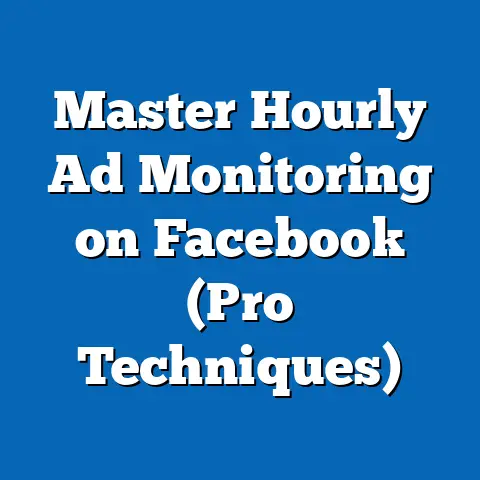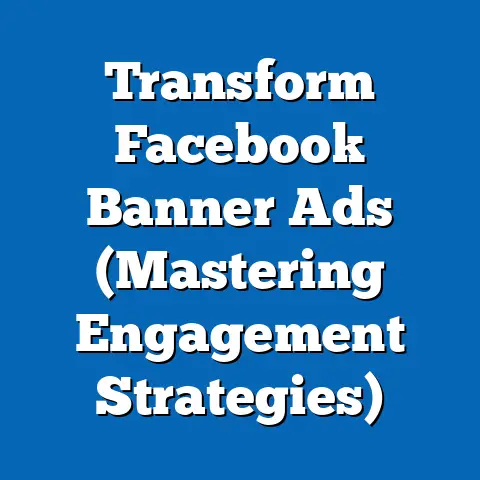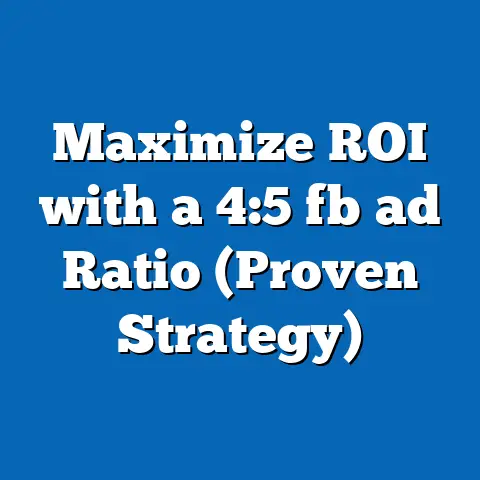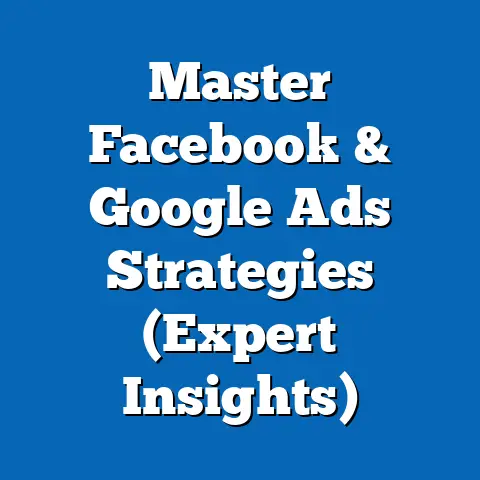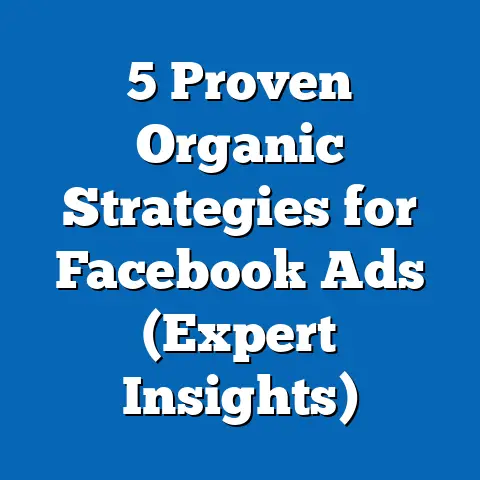Maximize Facebook Ads Potential (Expert Strategies Unveiled)
Sustainability in digital marketing isn’t just a buzzword – it’s a necessity. It’s about building long-term strategies that not only drive results but also contribute positively to the environment and society. As a digital marketing expert, I’ve seen firsthand how impactful sustainable practices can be, especially within the realm of Facebook advertising.
Facebook, with its vast reach and sophisticated targeting capabilities, offers incredible potential for businesses. But it’s not enough to simply throw money at ads and hope for the best. To truly maximize your Facebook ads potential, you need a strategic, data-driven approach that aligns with sustainable business practices. This means creating campaigns that are not only effective but also ethical, responsible, and contribute to long-term growth.
Understanding Facebook Ads
Before we delve into the advanced strategies, let’s lay a solid foundation by understanding the fundamentals of Facebook advertising.
Facebook offers a diverse range of ad formats to suit various marketing objectives. Here’s a rundown of some of the most popular options:
- Image Ads: Simple yet effective, image ads are great for showcasing products or services with a visually appealing image and concise copy.
- Video Ads: Engaging and dynamic, video ads can capture attention and tell a compelling story. They’re perfect for brand awareness and driving conversions.
- Carousel Ads: Allow you to display multiple images or videos in a single ad, each with its own headline, description, and link. This format is ideal for showcasing a range of products or highlighting different features.
- Slideshow Ads: Combine multiple images or videos into a seamless slideshow with music and text. Slideshow ads are a cost-effective way to create visually appealing content.
- Collection Ads: Designed for mobile shoppers, collection ads feature a main video or image with related products displayed below. This format provides a seamless shopping experience within Facebook.
Understanding how Facebook’s algorithm works is crucial for maximizing your ad performance. The algorithm determines which ads are shown to which users based on a variety of factors, including:
- Relevance: How relevant is your ad to the user’s interests and behavior?
- Bid: How much are you willing to pay for each impression or click?
- Estimated Action Rate: How likely is the user to take the desired action (e.g., click, purchase, sign up)?
- Ad Quality: How engaging and informative is your ad?
To ensure your ads are seen by the right people, you need to master audience targeting. Facebook offers a range of targeting options, including demographic, interest-based, and behavioral targeting. I’ll delve deeper into audience targeting strategies in a later section.
Facebook provides two primary tools for managing your advertising efforts:
- Facebook Ads Manager: A comprehensive platform for creating, managing, and analyzing your ad campaigns. It’s where you’ll set your budget, choose your targeting options, design your ads, and track your performance.
- Facebook Business Manager: A centralized platform for managing your Facebook pages, ad accounts, and other business assets. It’s ideal for agencies and businesses with multiple users and accounts.
To track the success of your Facebook ad campaigns, you need to monitor key metrics such as:
- Click-Through Rate (CTR): The percentage of people who see your ad and click on it. A high CTR indicates that your ad is relevant and engaging.
- Cost Per Click (CPC): The amount you pay each time someone clicks on your ad. A low CPC means you’re getting good value for your ad spend.
- Return on Ad Spend (ROAS): The amount of revenue you generate for every dollar you spend on advertising. A high ROAS indicates that your campaigns are profitable.
- Conversion Rate: The percentage of people who take the desired action after clicking on your ad (e.g., purchase, sign up, download). A high conversion rate means your landing page is effective.
Understanding these fundamentals is essential for creating successful Facebook ad campaigns. Now, let’s move on to crafting effective ads that capture attention and drive results.
Key Takeaway: Understanding the different ad formats, the Facebook algorithm, and key metrics is crucial for building a solid foundation for your Facebook advertising efforts.
Crafting Effective Facebook Ads
Creating effective Facebook ads is an art and a science. It requires a deep understanding of your target audience, a creative flair for crafting compelling content, and a data-driven approach to optimizing your campaigns.
The elements of a compelling ad copy and visuals are:
- Headline: Your headline is the first thing people see, so it needs to be attention-grabbing and relevant. Use strong verbs, numbers, and questions to pique interest. For example, “Discover the Secret to [Desired Outcome]” or “5 Proven Ways to [Achieve Goal].”
- Body Text: Your body text should provide more detail about your offer and explain why people should take action. Focus on the benefits, not just the features. Use clear, concise language and avoid jargon.
- Call to Action (CTA): Your CTA tells people what you want them to do next. Use strong action verbs like “Shop Now,” “Learn More,” or “Sign Up.” Make your CTA button prominent and easy to click.
- Images and Videos: High-quality visuals are essential for capturing attention and conveying your message. Use professional-looking photos or videos that are relevant to your offer and target audience.
High-quality images and videos are crucial because they instantly grab attention and communicate your message effectively. They should be visually appealing, relevant to your offer, and optimized for Facebook’s ad specifications.
A/B testing, also known as split testing, is a powerful technique for optimizing your ad content. It involves creating multiple versions of your ad with slight variations and testing them against each other to see which performs best.
For example, you could test different headlines, images, or CTAs to see which generates the highest CTR or conversion rate. A/B testing allows you to make data-driven decisions and continuously improve your ad performance.
I remember working on a campaign for a local coffee shop. We initially used a generic image of a coffee cup in our ads. After running A/B tests with different images, we discovered that an image of a barista interacting with a customer generated a significantly higher CTR. This simple change made a huge difference in the overall performance of the campaign.
Here are some examples of successful ad campaigns that effectively utilized creative elements:
- Dollar Shave Club: Their humorous and irreverent video ads went viral, helping them disrupt the razor industry.
- Old Spice: Their “The Man Your Man Could Smell Like” campaign used witty and engaging video ads to revitalize their brand.
- Airbnb: Their visually stunning photos and videos showcase unique travel experiences, inspiring people to book their next adventure.
Key Takeaway: Crafting effective Facebook ads requires a combination of creative storytelling, high-quality visuals, and data-driven optimization through A/B testing.
Audience Targeting Strategies
One of the biggest advantages of Facebook advertising is its sophisticated audience targeting capabilities. By targeting the right people with the right message, you can significantly improve your ad performance and maximize your ROI.
Facebook offers three main types of audiences:
- Core Audiences: Allow you to target people based on demographic, interest-based, and behavioral data. You can target people based on age, gender, location, education, interests, hobbies, and more.
- Custom Audiences: Allow you to target people who have already interacted with your business, such as website visitors, email subscribers, or customers. You can upload your customer list or use Facebook’s pixel to track website visitors.
- Lookalike Audiences: Allow you to target people who are similar to your existing customers or website visitors. Facebook analyzes the characteristics of your source audience and finds people who share similar traits.
Demographic, interest-based, and behavioral targeting are all powerful tools for reaching your ideal customers. Demographic targeting allows you to target people based on age, gender, location, education, and other demographic factors. Interest-based targeting allows you to target people based on their interests, hobbies, and passions. Behavioral targeting allows you to target people based on their online behavior, such as purchase history, website visits, and app usage.
Pixel tracking and retargeting strategies are essential for reaching people who have already shown an interest in your business. Facebook’s pixel is a small piece of code that you install on your website. It allows you to track website visitors and their actions, such as page views, product views, and purchases.
With pixel tracking, you can create retargeting campaigns that show ads to people who have visited your website but haven’t yet made a purchase or taken the desired action. Retargeting is a highly effective way to re-engage potential customers and drive conversions.
I once worked with an e-commerce client who was struggling to convert website visitors into customers. By implementing pixel tracking and retargeting, we were able to show ads to people who had viewed specific products on their website but hadn’t added them to their cart. This resulted in a significant increase in sales and a much higher ROI on their ad spend.
Here are some examples showcasing successful audience targeting:
- A clothing retailer: Targeted women aged 25-45 who were interested in fashion and online shopping.
- A fitness studio: Targeted people who lived within a 5-mile radius of their studio and were interested in fitness and healthy living.
- A software company: Targeted business owners and marketing professionals who were interested in digital marketing and productivity tools.
Key Takeaway: Mastering audience targeting is crucial for reaching the right people with the right message and maximizing your Facebook ad performance.
Budgeting and Bidding Strategies
Setting the right budget and choosing the right bidding strategy are essential for maximizing your ROI on Facebook ads. There are two main budgeting methods:
- Daily Budget: Sets the average amount you’re willing to spend each day on your ad campaign.
- Lifetime Budget: Sets the total amount you’re willing to spend over the entire duration of your ad campaign.
The best budgeting method depends on your specific goals and resources. A daily budget is ideal for ongoing campaigns with a consistent flow of traffic. A lifetime budget is better for campaigns with a specific start and end date, such as a product launch or promotional event.
Facebook offers two main bidding strategies:
- Automatic Bidding: Facebook automatically sets your bids based on your budget and target audience. This is a good option for beginners or those who want to save time.
- Manual Bidding: You manually set your bids for each ad set or campaign. This gives you more control over your ad spend and allows you to optimize your bids based on performance data.
Automatic bidding is a good starting point, but manual bidding can be more effective for experienced advertisers who want to fine-tune their campaigns.
When allocating your budget for different campaigns and ad sets, consider the following factors:
- Your Goals: What are you trying to achieve with each campaign?
- Your Target Audience: How large and engaged is your target audience?
- Your Ad Relevance: How relevant and engaging is your ad content?
- Your Competition: How much are your competitors bidding?
To scale successful campaigns while managing costs effectively, gradually increase your budget and monitor your performance closely. Use A/B testing to optimize your ad content and bidding strategies. Consider using campaign budget optimization (CBO) to automatically allocate your budget across different ad sets.
I’ve seen many advertisers make the mistake of increasing their budget too quickly, which can lead to a spike in costs and a decrease in ROI. It’s important to scale your campaigns gradually and monitor your performance closely to ensure you’re getting the best possible results.
Key Takeaway: Setting the right budget and choosing the right bidding strategy are crucial for maximizing your ROI on Facebook ads.
Analyzing and Optimizing Ad Performance
Data analysis is the key to refining your ad strategies and maximizing your ROI. Facebook Ads Analytics provides a wealth of data about your ad performance, including:
- Impressions: The number of times your ad was shown.
- Reach: The number of unique people who saw your ad.
- Clicks: The number of times people clicked on your ad.
- CTR: The percentage of people who saw your ad and clicked on it.
- CPC: The amount you paid each time someone clicked on your ad.
- Conversions: The number of people who took the desired action after clicking on your ad.
- ROAS: The amount of revenue you generated for every dollar you spent on advertising.
Focus on the metrics that are most relevant to your goals. For example, if you’re trying to drive website traffic, focus on CTR and CPC. If you’re trying to generate leads, focus on conversion rate and cost per lead. If you’re trying to drive sales, focus on ROAS.
Based on your performance data, take the following actions:
- Optimize Your Targeting: Refine your audience targeting to reach the most relevant people.
- Improve Your Ad Content: A/B test different headlines, images, and CTAs to see which performs best.
- Adjust Your Bidding Strategy: Optimize your bids to get the most value for your ad spend.
- Pause Underperforming Ads: Stop spending money on ads that aren’t generating results.
Ongoing testing and adjustments are essential for maximizing your ad performance. Continuously monitor your data, test new ideas, and refine your strategies based on what you learn.
I’ve found that the most successful advertisers are those who are constantly testing and optimizing their campaigns. They don’t just set it and forget it. They’re always looking for ways to improve their performance and get the most out of their ad spend.
Key Takeaway: Data analysis is the key to refining your ad strategies and maximizing your ROI. Continuously monitor your data, test new ideas, and refine your strategies based on what you learn.
Staying Ahead of Facebook Ads Trends
The world of Facebook advertising is constantly evolving. New features, algorithm updates, and policy changes are introduced regularly, so it’s important to stay ahead of the curve to maintain a competitive edge.
Here are some emerging trends in Facebook advertising:
- Video Content: Video ads are becoming increasingly popular and effective. They capture attention and tell a compelling story.
- AR Ads: Augmented reality (AR) ads allow users to interact with your products in a virtual environment. This can be a highly engaging and memorable experience.
- Personalized Ads: Personalized ads are tailored to individual users based on their interests, behavior, and past interactions. This can significantly improve ad relevance and engagement.
Algorithm updates and policy changes can have a significant impact on your advertising strategies. It’s important to stay informed about these changes and adjust your campaigns accordingly.
For example, Facebook has recently made changes to its targeting options, limiting the ability to target people based on certain demographic and interest-based data. This means you may need to find new ways to reach your target audience.
Continuous education and adaptation are essential for staying relevant in the industry. Attend webinars, read industry blogs, and follow thought leaders on social media to stay up-to-date on the latest trends and best practices.
I make it a point to dedicate time each week to learning about the latest trends and best practices in Facebook advertising. This helps me stay ahead of the curve and provide the best possible service to my clients.
Key Takeaway: Staying ahead of Facebook ads trends requires continuous education, adaptation, and a willingness to experiment with new strategies.
Conclusion
Maximizing your Facebook ads potential requires a strategic, data-driven approach that aligns with sustainable business practices. By understanding the fundamentals of Facebook advertising, crafting effective ads, mastering audience targeting, setting the right budget, analyzing your performance, and staying ahead of the trends, you can unlock the full potential of this powerful platform.
Remember, sustainability in digital marketing is not just a buzzword – it’s a necessity. By creating campaigns that are not only effective but also ethical, responsible, and contribute to long-term growth, you can build a sustainable business that benefits both your bottom line and the world around you.
Now, it’s time to put these expert strategies into practice and maximize your Facebook ads potential. Good luck!

